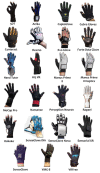A Systematic Review of Commercial Smart Gloves: Current Status and Applications
- PMID: 33920101
- PMCID: PMC8070066
- DOI: 10.3390/s21082667
A Systematic Review of Commercial Smart Gloves: Current Status and Applications
Abstract
Smart gloves have been under development during the last 40 years to support human-computer interaction based on hand and finger movement. Despite the many devoted efforts and the multiple advances in related areas, these devices have not become mainstream yet. Nevertheless, during recent years, new devices with improved features have appeared, being used for research purposes too. This paper provides a review of current commercial smart gloves focusing on three main capabilities: (i) hand and finger pose estimation and motion tracking, (ii) kinesthetic feedback, and (iii) tactile feedback. For the first capability, a detailed reference model of the hand and finger basic movements (known as degrees of freedom) is proposed. Based on the PRISMA guidelines for systematic reviews for the period 2015-2021, 24 commercial smart gloves have been identified, while many others have been discarded because they did not meet the inclusion criteria: currently active commercial and fully portable smart gloves providing some of the three main capabilities for the whole hand. The paper reviews the technologies involved, main applications and it discusses about the current state of development. Reference models to support end users and researchers comparing and selecting the most appropriate devices are identified as a key need.
Keywords: extended reality; hand and finger pose estimation and motion tracking; haptic feedback; kinesthetic feedback; smart gloves; tactile feedback.
Conflict of interest statement
The authors declare no conflict of interest.
Figures







Similar articles
-
A rapid and systematic review of the clinical effectiveness and cost-effectiveness of paclitaxel, docetaxel, gemcitabine and vinorelbine in non-small-cell lung cancer.Health Technol Assess. 2001;5(32):1-195. doi: 10.3310/hta5320. Health Technol Assess. 2001. PMID: 12065068
-
Home treatment for mental health problems: a systematic review.Health Technol Assess. 2001;5(15):1-139. doi: 10.3310/hta5150. Health Technol Assess. 2001. PMID: 11532236
-
Cost-effectiveness of using prognostic information to select women with breast cancer for adjuvant systemic therapy.Health Technol Assess. 2006 Sep;10(34):iii-iv, ix-xi, 1-204. doi: 10.3310/hta10340. Health Technol Assess. 2006. PMID: 16959170
-
Use of Augmented Reality for Training Assistance in Laparoscopic Surgery: Scoping Literature Review.J Med Internet Res. 2025 Jan 28;27:e58108. doi: 10.2196/58108. J Med Internet Res. 2025. PMID: 39874568 Free PMC article.
-
Interventions for preventing occupational irritant hand dermatitis.Cochrane Database Syst Rev. 2018 Apr 30;4(4):CD004414. doi: 10.1002/14651858.CD004414.pub3. Cochrane Database Syst Rev. 2018. PMID: 29708265 Free PMC article.
Cited by
-
Sensing System for Plegic or Paretic Hands Self-Training Motivation.Sensors (Basel). 2022 Mar 21;22(6):2414. doi: 10.3390/s22062414. Sensors (Basel). 2022. PMID: 35336583 Free PMC article.
-
Robust hand tracking for surgical telestration.Int J Comput Assist Radiol Surg. 2022 Aug;17(8):1477-1486. doi: 10.1007/s11548-022-02637-9. Epub 2022 May 27. Int J Comput Assist Radiol Surg. 2022. PMID: 35624404 Free PMC article.
-
Static and Dynamic Hand Gestures: A Review of Techniques of Virtual Reality Manipulation.Sensors (Basel). 2024 Jun 9;24(12):3760. doi: 10.3390/s24123760. Sensors (Basel). 2024. PMID: 38931542 Free PMC article. Review.
-
Somesthetic, Visual, and Auditory Feedback and Their Interactions Applied to Upper Limb Neurorehabilitation Technology: A Narrative Review to Facilitate Contextualization of Knowledge.Front Rehabil Sci. 2022 Mar 1;3:789479. doi: 10.3389/fresc.2022.789479. eCollection 2022. Front Rehabil Sci. 2022. PMID: 36188924 Free PMC article. Review.
-
Tactile Gloves Predict Load Weight During Lifting With Deep Neural Networks.IEEE Sens J. 2023 Jun;23(16):18798-18809. doi: 10.1109/jsen.2023.3289670. IEEE Sens J. 2023. PMID: 40160413 Free PMC article.
References
-
- Slater M., Lotto B., Arnold M.M., Sanchez-Vives M.V. How we experience immersive virtual environments: The concept of presence and its measurement. Anu. Psicol. 2009;40:193–210.
-
- Valkov D., Linsen L. Vibro-tactile feedback for real-world awareness in immersive virtual environments; Proceedings of the 2019 IEEE Conference on Virtual Reality and 3D User Interfaces (VR); Osaka, Japan. 23–27 March 2019; New York, NY, USA: IEEE; 2019. pp. 340–349. - DOI
-
- Caserman P., Garcia-Agundez A., Konrad R., Göbel S., Steinmetz R. Real-time body tracking in virtual reality using a Vive tracker. Virtual Real. 2019;23:155–168. doi: 10.1007/s10055-018-0374-z. - DOI
Publication types
MeSH terms
LinkOut - more resources
Full Text Sources
Other Literature Sources
Medical

